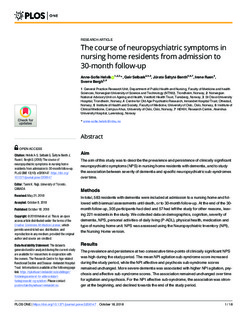| dc.contributor.author | Helvik, Anne-Sofie | |
| dc.contributor.author | Selbæk, Geir | |
| dc.contributor.author | Saltyte Benth, Jurate | |
| dc.contributor.author | Røen, Irene Mari | |
| dc.contributor.author | Bergh, Sverre | |
| dc.date.accessioned | 2019-03-08T08:59:45Z | |
| dc.date.available | 2019-03-08T08:59:45Z | |
| dc.date.created | 2018-10-22T14:52:33Z | |
| dc.date.issued | 2018 | |
| dc.identifier.citation | PLoS ONE. 2018, 13:e0206147 (10), 1-18. | nb_NO |
| dc.identifier.issn | 1932-6203 | |
| dc.identifier.uri | http://hdl.handle.net/11250/2589291 | |
| dc.description.abstract | Aim
The aim of this study was to describe the prevalence and persistence of clinically significant neuropsychiatric symptoms (NPS) in nursing home residents with dementia, and to study the association between severity of dementia and specific neuropsychiatric sub-syndromes over time.
Methods
In total, 583 residents with dementia were included at admission to a nursing home and followed with biannual assessments until death, or to 30-month follow-up. At the end of the 30-month follow-up, 305 participants had died and 57 had left the study for other reasons, leaving 221 residents in the study. We collected data on demographics, cognition, severity of dementia, NPS, personal activities of daily living (P-ADL), physical health, medication and type of nursing home unit. NPS was assessed using the Neuropsychiatric Inventory (NPI), the Nursing Home version.
Results
The prevalence and persistence at two consecutive time-points of clinically significant NPS was high during the study period. The mean NPI agitation sub-syndrome score increased during the study period, while the NPI affective and psychosis sub-syndrome scores remained unchanged. More severe dementia was associated with higher NPI agitation, psychosis and affective sub-syndrome scores. The association remained unchanged over time for agitation and psychosis. For the NPI affective sub-syndrome, the association was stronger at the beginning, and declined towards the end of the study period.
Conclusion
The findings of high prevalence and persistence at two consecutive time points of clinically significant NPS over time, and the associations between severity of dementia and NPI sub-syndromes shed light on the burden and care needs of nursing home residents with dementia after admission to nursing home care. This information is of interest to health care planners and providers to enable them to increase the quality of care for nursing home residents. | nb_NO |
| dc.language.iso | eng | nb_NO |
| dc.publisher | Public Library of Science | nb_NO |
| dc.relation.uri | https://journals.plos.org/plosone/article/file?id=10.1371/journal.pone.0206147&type=printable | |
| dc.rights | Navngivelse 4.0 Internasjonal | * |
| dc.rights.uri | http://creativecommons.org/licenses/by/4.0/deed.no | * |
| dc.title | The course of neuropsychiatric symptoms in nursing home residents from admission to 30-month follow-up | nb_NO |
| dc.type | Journal article | nb_NO |
| dc.type | Peer reviewed | nb_NO |
| dc.description.version | publishedVersion | nb_NO |
| dc.source.pagenumber | 1-18 | nb_NO |
| dc.source.volume | 13:e0206147 | nb_NO |
| dc.source.journal | PLoS ONE | nb_NO |
| dc.source.issue | 10 | nb_NO |
| dc.identifier.doi | 10.1371/journal.pone.0206147 | |
| dc.identifier.cristin | 1622318 | |
| dc.description.localcode | © 2018 Helvik et al. This is an open access article distributed under the terms of the Creative Commons Attribution License, which permits unrestricted use, distribution, and reproduction in any medium, provided the original author and source are credited. | nb_NO |
| cristin.unitcode | 194,65,20,0 | |
| cristin.unitname | Institutt for samfunnsmedisin og sykepleie | |
| cristin.ispublished | true | |
| cristin.fulltext | original | |
| cristin.qualitycode | 1 | |

